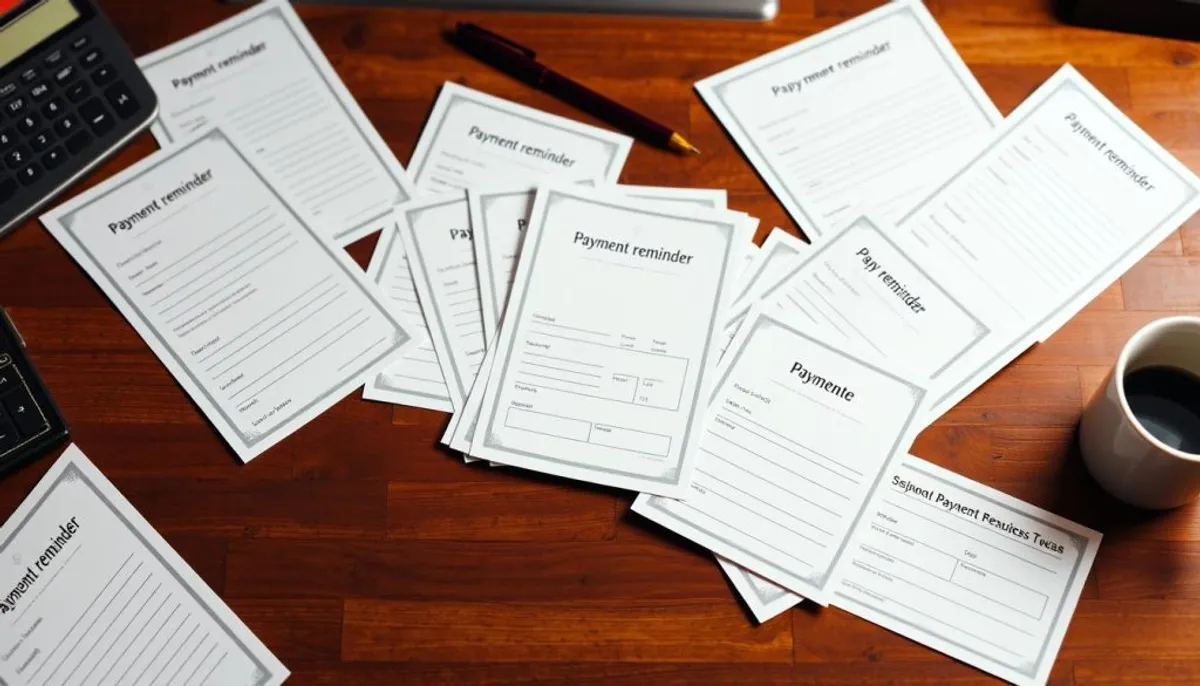Managing overdue invoices requires finesse. It’s essential to strike a balance between being friendly and ensuring timely payment. Implementing effective late payment reminders is vital for maintaining a healthy cash flow. By honing your customer communication skills, you can significantly improve your chances of collecting outstanding debts.
Timely reminders can be surprisingly effective. A gentle email reminder the day after the due date can prompt action. It often serves as the catalyst customers need. Providing diverse payment options further facilitates timely payments. Options like credit cards, checks, and online portals simplify the process for clients.

Adopting a professional demeanor is crucial. Emails that are clear and friendly tend to yield better results than phone calls or texts. Ensure your reminders include all relevant information, such as invoice copies and payment terms. This transparency can expedite the payment process.
Key Takeaways
- Send payment reminders promptly after the due date
- Offer various payment methods to customers
- Use clear, friendly emails for late payment reminders
- Include necessary details in your reminders
- Maintain a professional tone in all communications
- Follow up regularly with late-paying customers
- Consider using templates for consistency
Understanding the Impact of Overdue Payments
Overdue payments are a major hurdle for businesses, notably small and medium-sized enterprises (SMEs). In 2023, SMBs are burdened with $825 billion in unpaid invoices. This underscores the critical need for robust accounts receivable management.
Effects on Business Cash Flow
Late payments severely disrupt cash flow, impeding business growth and operations. UK SMEs face payments delayed by an average of 18 days, with 1 in 6 invoices unpaid after 90 days. This delay compels business owners to dedicate about 14 hours weekly to payment chasing, detracting from their core activities.
Importance of Timely Payments
Timely payments are essential for financial stability and cash flow enhancement. Strategies like Direct Debit can significantly boost the chances of receiving full, on-time payments. Effective communication is paramount, as 25% of British small businesses shy away from discussing financial matters with customers.
Common Reasons for Late Payments
Understanding the causes of payment delays is crucial for managing delinquent accounts. Common reasons include:
- Lost invoices in busy accounting departments
- Forgotten due dates
- Customer cash flow issues
- Unclear payment terms
| Late Payment Stage | Recommended Action |
|---|---|
| 1-30 days | Polite reminder email |
| 31-60 days | Firm reminder with late fees |
| 60+ days | Final notice and consider legal options |
By acknowledging these factors, businesses can devise effective strategies for requesting overdue payments. This approach helps maintain positive customer relationships while protecting their financial well-being.
Preparing to Request Overdue Payments
Preparing to request overdue payments necessitates meticulous planning. Effective invoice management commences with a comprehensive review of all details. This foundational step is crucial for avoiding errors and ensuring a seamless process.
Reviewing Invoice Details
It is imperative to meticulously scrutinize every aspect of your invoice. Verify the accuracy of all information, encompassing the client’s name and the services rendered. Such diligence in detail prevents potential disputes and accelerates the payment process.
Confirming Payment Terms
Clear payment terms are indispensable for prompt payments. It is essential to review the agreed-upon terms with your client. Common terms include Net 30, Due on Receipt, or specific due dates. A thorough understanding of these terms facilitates the initiation of follow-up actions.
Gathering Necessary Documentation
Accumulate all documentation pertinent to overdue payments. This encompasses:
- Original invoice
- Contract or agreement
- Proof of delivered goods or services
- Any relevant emails or communications
Having these documents at the ready fortifies your stance and supports your payment request. It also underscores your professionalism and organizational prowess in invoice management.
Remember, preparation is paramount when addressing overdue payments. By meticulously reviewing details, confirming terms, and compiling documentation, you establish a robust foundation for successful payment collection. This strategy not only preserves client relationships but also ensures timely payment for your business.
Crafting Effective Payment Reminder Emails
Creating impactful payment reminder templates is crucial for successful email communication strategies. Professional payment requests can significantly improve your cash flow and maintain positive customer relationships. Let’s explore some key elements of crafting effective reminder emails.

Timing plays a vital role in the effectiveness of payment reminders. Send a pre-due-date reminder 3-5 days before the invoice is due. This proactive approach can reduce overdue payments. If the invoice remains unpaid, follow this timeline:
- 1-3 days after due date: Send a polite reminder
- 5-7 days after due date: Send an early overdue reminder
- 14-21 days after due date: Send a persistent reminder
- 30-45 days after due date: Send a final reminder
When crafting your payment reminder templates, include these essential elements:
- Clear subject line
- Invoice number and due amount
- Copy of the original invoice
- Restated payment terms
- Complete payment information
- Friendly yet firm tone
Remember, the goal is to provide helpful information rather than make accusations. By implementing these email communication strategies, you can improve your chances of receiving timely payments while maintaining professional relationships with your customers.
| Reminder Type | Timing | Tone |
|---|---|---|
| Pre-due reminder | 3-5 days before due date | Friendly |
| First overdue reminder | 1-3 days after due date | Polite |
| Persistent reminder | 14-21 days after due date | Firm |
| Final reminder | 30-45 days after due date | Urgent |
How to Ask Overdue Payment from Customer
Requesting overdue payments can be challenging. With nearly half of all business invoices in the United States becoming overdue, mastering this skill is essential. We will explore effective customer communication tips and payment collection strategies to navigate these situations professionally.
Using a Polite but Firm Tone
When requesting payments, aim for a balance between politeness and firmness. Your tone should be friendly yet assertive. Given that 53% of freelancers face late payments four or more times annually, you’re not alone in this challenge.
Providing Clear Payment Instructions
Ensure customers can pay easily. Offer various payment methods like checks, electronic funds transfers, and PayPal. Clear instructions can greatly enhance your success rate in collecting payments.
Setting Deadlines for Response
Set clear deadlines for payment or response. Send reminders and wait a week before following up. If emails remain unanswered, consider a phone call. This proactive strategy can prevent the 79% of small businesses that couldn’t pay themselves due to late payments in 2017.
| Payment Collection Strategy | Effectiveness |
|---|---|
| Polite but firm communication | High |
| Clear payment instructions | Very High |
| Setting specific deadlines | Moderate to High |
| Offering multiple payment methods | High |
| Phone follow-up | Moderate to High |
Implementing a Progressive Follow-up Strategy
Developing a structured follow-up strategy is essential for managing overdue payments. Effective payment follow-up techniques can enhance cash flow and foster strong client relationships. Let’s examine the core components of a progressive debt collection strategy.
Initiate with gentle reminders shortly after the due date. A polite email or message should inform the customer of the missed payment. As time elapses, escalate the urgency of your communications. This escalation process emphasizes the significance of settling the outstanding balance.
Consider offering a grace period for late payments. This approach can prompt timely resolution while preserving goodwill. If the invoice remains unpaid, introduce late fees or interest charges as stipulated in your original payment terms. Utilizing tools like FreshBooks can automate this process, applying charges to past-due invoices.
- Send reminders at regular intervals (e.g., 1 day, 1 week, 2 weeks after due date)
- Adjust the tone and urgency of messages as time passes
- Offer payment plans or recurring payment options to increase collection likelihood
- Use automated systems to reduce human error and improve efficiency
The objective is to recover payments while safeguarding customer relationships. If all attempts fail, consider professional debt collection agencies as a last resort. By adhering to a systematic approach, businesses can optimize their debt recovery process and sustain a healthy cash flow.
Offering Alternative Payment Options
Enhancing customer retention is achievable by introducing flexible payment options. Given that 54% of small and medium-sized enterprises face late payments, it’s imperative to tailor payment methods to customer requirements.
Payment Plans and Installments
Implementing payment plans can alleviate financial stress for customers. By dividing large invoices into smaller, more manageable installments, the likelihood of payment increases. This gesture of empathy can significantly bolster customer relationships.
Multiple Payment Methods
Adopting a variety of payment methods enhances customer convenience and satisfaction. Acceptance of credit cards, online transfers, and checks streamlines the payment process. Platforms like PayPal, Payoneer, and Deel provide numerous options for seamless transactions.

Early Payment Incentives
Incentivize timely payments with rewards for early settlement. A small discount for payments before the due date can enhance cash flow and mitigate the 6-day delay in late payments.
| Payment Option | Benefits |
|---|---|
| Installment Plans | Eases financial burden, improves collection rates |
| Multiple Payment Methods | Increases convenience, caters to customer preferences |
| Early Payment Discounts | Encourages timely payments, improves cash flow |
By integrating these flexible payment options, businesses can address common late payment issues and enhance their financial health. Adapting to customer needs is fundamental to successful customer retention strategies.
Handling Difficult Conversations with Late-Paying Customers
Addressing overdue payments necessitates a nuanced approach, blending customer relationship management with conflict resolution. The essence of professional communication cannot be overstated in these interactions. Research indicates that businesses dedicate approximately 14 hours each week to late payment follow-ups, underscoring the critical need for effective strategies.
In navigating these conversations, it is crucial to exude calmness and empathy. Engage in active listening to understand the customer’s perspective on delayed payment. Simultaneously, assert the importance of fulfilling payment commitments. Propose alternatives such as payment plans or different payment methods to facilitate the process.
Several strategies can be employed to manage challenging payment discussions:
- Regularly review receivables to efficiently track late payments
- Dispatch reminder letters a few days prior to due dates
- Engage in direct communication via phone calls
- Present installment plans or partial payment options
- Introduce pre-payment incentives for future transactions
Establishing clear policies and utilizing automated reminders can significantly streamline the payment process. Tools like Service Provider Pro (SPP) facilitate the timely issuance of invoice reminders, thus reducing manual labor. It is noteworthy that businesses that diligently follow up on 90% or more of their invoices are more likely to receive payment within a week of the due date.
| Strategy | Effectiveness |
|---|---|
| Weekly receivables review | High |
| Pre-due date reminders | Medium |
| Phone calls | High |
| Payment plans | Medium |
| Automated reminders | High |
By adopting these strategies, you can enhance your success rate in resolving payment disputes while preserving positive customer relationships.
Leveraging Technology for Automated Payment Reminders
Today’s businesses face the daunting task of managing a plethora of invoices. A mid-market company, for instance, issues an average of 2,433 invoices monthly. This volume renders manual tracking and reminders impractical. Thus, accounts receivable automation emerges as a transformative solution for efficient payment collection.
Benefits of Automated Systems
Payment reminder software brings about substantial benefits. It streamlines the collection process, saving businesses valuable time and enhancing cash flow. For example, RPT Realty, an NYSE-listed REIT, has saved $64,200 annually through collaborative accounts receivable efforts. Automated systems ensure consistent follow-ups at critical intervals – 1, 15, 30, 45, 60, and 90 days past due.
Popular Software Solutions
Various software options are available for automated invoicing needs. These tools offer customizable templates and scheduling options. They can send reminders via email or text, accommodating customer preferences. Some solutions also integrate with existing accounting systems for seamless operations.
Customizing Automated Messages
Effective payment reminders include essential details: invoice number, overdue days, and payment links. This information prevents unnecessary back-and-forth, accelerating collections. Customization allows businesses to maintain a personal touch while ensuring timely communication. Achieving a balance between friendliness and professionalism in these messages is crucial.
By leveraging technology for payment reminders, businesses can significantly enhance their accounts receivable process. This approach not only saves time but also strengthens customer relationships and ensures a steady cash flow.
Conclusion
Effective payment collection is vital for enhancing business cash flow and preserving customer relationships. The statistics are stark: 82% of small businesses fail due to inadequate cash flow management, often stemming from late payments. This issue is widespread, with 79% of business owners unable to pay their own salaries due to delayed customer payments.
To address this, businesses must adopt a strategic approach. Email reminders are highly effective, as 99% of individuals check their inbox daily. For a more personal touch, mailed reminders can be impactful, with 77% of people immediately sorting through their mail. Text reminders are also a viable option, given that 80% of Americans ignore calls from unknown numbers.
Timing is crucial. Sending a reminder the day after a payment is due keeps it top of mind for the client. Implementing a 5% late fee after 30-60 days can also encourage timely payments. By employing these strategies and leveraging technology for automated reminders, businesses can enhance their cash flow and build stronger, more reliable customer relationships.
RelatedRelated articles



